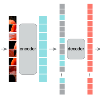In Internet of things (IoT), data is continuously recorded from different data sources and devices can suffer faults in their embedded electronics, thus leading to a high-dimensional data sets and concept drift events. Therefore, methods that are capable of high-dimensional non-stationary time series are of great value in IoT applications. Fuzzy Time Series (FTS) models stand out as data-driven non-parametric models of easy implementation and high accuracy. Unfortunately, FTS encounters difficulties when dealing with data sets of many variables and scenarios with concept drift. We present a new approach to handle high-dimensional non-stationary time series, by projecting the original high-dimensional data into a low dimensional embedding space and using FTS approach. Combining these techniques enables a better representation of the complex content of non-stationary multivariate time series and accurate forecasts. Our model is able to explain 98% of the variance and reach 11.52% of RMSE, 2.68% of MAE and 2.91% of MAPE.
翻译:在互联网(IoT)中,从不同数据源和装置不断记录数据,其嵌入式电子数据可能会有缺陷,从而导致高维数据集和概念漂移事件,因此,能够高维非静止时间序列的方法在IoT应用中具有巨大价值。Futzzy Time Series(FTS)模型作为数据驱动的非参数模型,很容易实施,而且精确度很高。不幸的是,FTS在处理由多种变量和情景组成的数据集时遇到概念漂移的难题。我们提出了一个处理高维非静止时间序列的新办法,将原始高维数据投射到低维嵌入空间,并使用FTS方法。这些技术相结合,可以更好地反映非静止多变时间序列和准确预报的复杂内容。我们的模型能够解释98%的差异并达到RME的11.52%、MAE的2.68%和MAPE的2.91%。




